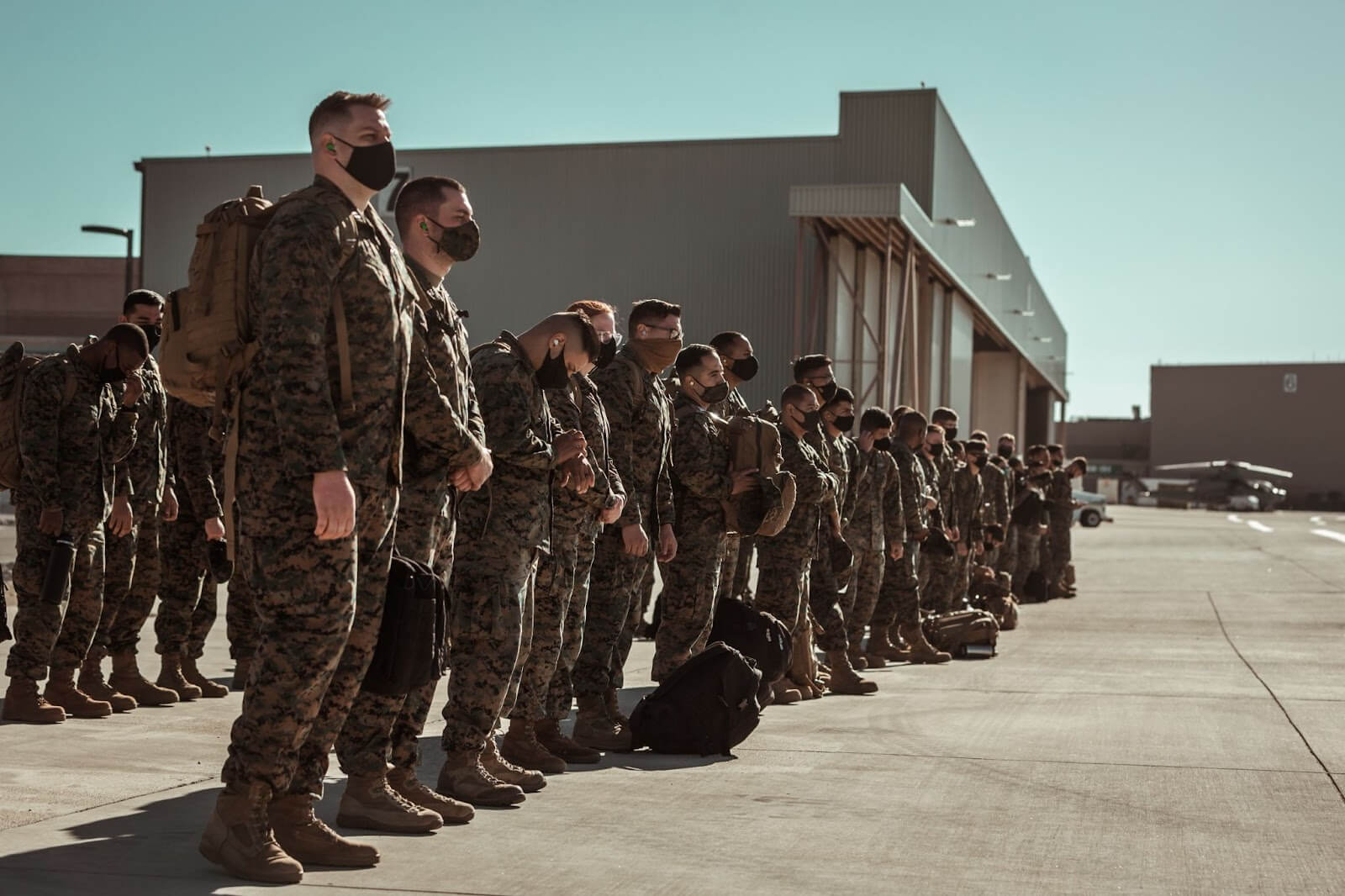The Army and Marines both pride themselves on being the toughest, most well-rounded soldiers in the United States Armed Forces. Although the two military service branches have significant similarities, they also carry distinctions that separate themselves as well.
Read more to learn about the four ways in which the Army and Marines are different.
1. Duties
When comparing the two branches of militaries side-by-side, one major note to make is the sheer size that differentiates these two organizations. The Army is the largest branch among the United States Armed Forces, and the Marine Corps is one of the smallest. While the Army has significantly more troops than the Marines, their counterpart possesses a more diverse aviation arm due to the Marine’s relationship with the Navy.
Since the Marines have a sparser amount of troops, they have the ability to perform a variety of military-based operations. The Marines are often referred to as “The nation’s force of readiness.” This moniker refers to how quickly they prepare for gaining footholds, responding to crises, and becoming engaged in operations. The Marines can deal with counterterrorism as well as military combat operations both independently and as a team with other military branches.
The United States Army is only responsible for land-based operations, meaning they only occupy military duties that take place on solid ground, whereas the Marines are considered to handle amphibious operations. This means that they can take control of military operations, whether those be land, air, or water.
While the Marines are properly trained to be the first units entering battle, the Army is prepared to remain in combat for extended periods of time. Their duties involve protecting the United States and securing resources, people, and land during foreign military campaigns.
Think of the Marines as almost a hybrid between the Army and Navy due to their versatility to perform similar operations. The Marines and Navy are often referred to as “sister services” as a result. Due to the Marines’ versatility to be forward-deployed in many different environments, they have an innate ability to adapt to various security needs requested by the United States government.
Although both branches have the main objective of preserving peace and security in the United States, the Army acts more like a defense of the United States by implementing their policies to foreign nations who take aggressive actions towards our country.
On the other hand, the Marines capture strategic points to provide easier routes towards enemy forces in the line of duty. The Marines also have a particularly distinct responsibility that the Army doesn’t have (along with the rest of the United States military branches): protection of United States embassies.
Since this duty is solely put upon the Marine Corps, they possess a specific unit within their branch called the Marine Corps Embassy Security Group, which is committed to guarding these embassies all across the world.
2. Command of Army vs. Marines
The United States Marines Corps is technically not as old as the Army; however, its earliest history goes back all the way to the American Revolutionary War. Separate from the Army, the Marines actually handle their operations under the United States Navy in order to carry out their task forces.
This means the Marine Corps relies on the Navy for technical and health support, whereas the Army provides their own religious, medical, and dental personnel for its own branch.
Both the Army and Marines organize their platoon sizes into larger companies with smaller squads underneath their command. However, the sizes of these squads typically will vary between the two branches of the military.
Army platoons usually consist of two four-man fire teams, which have as follows: leader, automatic rifleman, regular rifleman, and grenadier. One of these team members is pre-assigned to be the designated marksmen as well, whose role is to apply accurate fire for further distances. Army squads will also apply an extra infantry weapons squad along with each platoon, a practice that is not used by the United States Marine Corps.
Marine rifle platoon squads consist of three separate squads versus the Army’s two. Each platoon squad has a sergeant assigned to it that oversees three subsequent fire teams under the platoon itself.
The fire teams each contain a corporal: a member whom the squad leader may delegate responsibilities through for the rest of the squad. The fire team leader also possesses a bit of command too—they are responsible for the supervision of an automatic rifleman, assistant automatic rifleman, and regular rifleman.
3. Training
One of the key areas in which the Army and Marine Corps differentiate lies in their training programs. Although the length for these processes lasts for relatively the same amount of time, the course load alternates based on the routes each person decides to take. For starters, both branches require that enlistees complete the recruitment training prior to advancing to the designed schools.
Both the Marines and Army training have the same twelve-week length of training. Army enlistees must attend Advanced Individualized Training (IAT) schools while Marine enlistees enroll in Military Occupational Specialty (MOS) schools, respectively. Both of these branches offer different opportunities to become commissioned officers, as long as the trainees did not partake in the Reserve Officers Training Corps (ROTC) program.
The United States Naval Academy is located in Annapolis, MD. This four-year University trains co-ed officers-in-training (Midshipmen) along with a provided full tuition should the candidates enter duty following graduation. Because the Marines handle their operations under the Navy, this academy handles graduates of both the Navy and Marines.
Quantico, VA, is home to the United States Marine Corps Officer Candidates School that offers two six-week courses or one ten-week course to potential candidates who are either enrolled in commissioning programs targeting college students/graduates, enlisted Marines, and Navy graduates. After the completion of this school, the Midshipmen will receive the rank of 2nd Lieutenant.
On the contrary, the United States Military Academy is located in West Point, NY. This is a separate four-year program that prepares students for an Army service post-graduation. Similar to the Naval Academy, West Point also offers free tuition to those who enter active military duty once they complete their degree.
The United States Army Officer Candidates School is located in Fort Benning, GA, and is available to college graduates, enlisted members, and warrant officers. After the completion of the vigorous 12-week program, graduates receive the rank of Second Lieutenant in the United States Army.
4. Flags
The United States has separate flags designed for each branch of their respective military. The United States Army flag was originally designed with a War Office seal, containing the words “United States Army” and “1775” over a white background. Personal flags designed for Army Officers are vibrantly red - the highest-ranking five-star flag belonging to Generals.
The Marines’ flag has changed its appearance over the course of time due to its sibling-like relationship with the Navy. Their modern-day flag was not completed until the 20th century, as a matter of fact. Their personal flags designed for officers contain a darker tone of red with the highest rank assigned to their Marine Generals, respectively.
The Bold and the Brave
The United States boasts one of, if not the greatest armed forces across the entire globe. Strong as a whole, the individual branches of this impressive organization also have distinct differences that help contribute to the country’s military operations as a whole. Although the Army and Marine Corps contain similarities among the two respective branches, there are also key differences that separate them from one another.
Due to the size and power of the Army, they focus more on land-based combat, whereas the Marines are unique in their ability to perform a wide variety of operations, regardless of most of the environmental conditions. The Army acts as its own separate unit, while the Marines handle their operations under the guidance of the Navy.
The Marines are known for being the first troops to engage in battle, while the Army is prepared to remain in combat for extended periods of time. The Army is seen more so as a defender of the United States both domestically and abroad, whereas the Marines are viewed as the unit which captures vantage points to make it easier for the other branches to access.
The training programs vary in terms of location and overall course load to go on top of this, while both provide separate opportunity paths for those interested in becoming commissioned officers to the ranks of Second Lieutenant in their respective programs. Despite the schools being in separate locations and containing altering degree requirements, both West Point and The Naval Academy provide the opportunity for students to have free tuition under the notion that they will enter active duty post-graduation.
Finally, the branches even have differences among their respective flags. Both branches have separate flags in general; even their personal officer flags vary from one another. All in all, despite their significant differences, both the Army and Marines are essential pieces to the United States Armed Forces that work towards maintaining the peace and security of our free nation.
To represent your patriotism, fly high-quality American-made flags from Allegiance. At Allegiance, we know our country wouldn’t exist without the brave men and women in our armed forces. That’s why we partnered with nonprofit organizations like the Boot Campaign, the Best Defense Foundation, and Team RWB to support our troops that we owe everything to.
Sources:
Differences Between Army and Marines | Differencebetween.net
Army vs. Marines | Operation Military Kids
What Separates the Marines from the Other Branches? | United Services Organizations





